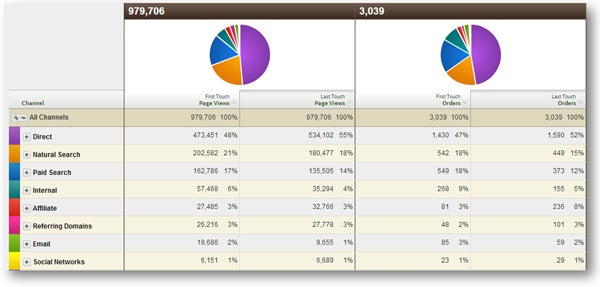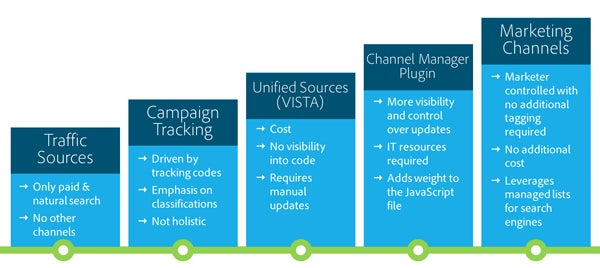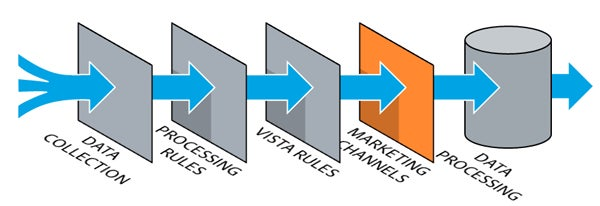One of the key reasons that many companies use web analytics is to determine how visitors found their web properties—essentially which channel (email, display ads, paid search, social networks, etc.) led them to a particular web property. As marketers, we want to know which of these marketing channels is the most effective, and with whom, so we can better target our efforts and receive a better return on our marketing dollars. In Adobe Analytics (formerly SiteCatalyst), the Marketing Channels reports are one of the tools that can help you track the influence of different channels on your web properties and give you useful channel insights.
While the Marketing Channels reports have been around for a while (2010 with SC 14.8), I still run into customers who aren’t using them effectively. I thought a refresher on this subject would be helpful to new and old customers. If you’re unfamiliar with these reports, you essentially configure a set of processing rules in the Admin Tools interface to assign traffic to various marketing channels using a basic waterfall approach. You’ll then have a first-touch and last-touch attribution view how each channel performed in terms of traffic volume and conversion metrics. You can subsequently drill into details for each channel, depending on how you’ve set up your reporting for each one.
To take full advantage of the Marketing Channels reports, you must understand how the data is processed and flows through the system into the reports. In this four-part blog series, I intend to explore:
- The evolution of marketing channel reporting in Adobe Analytics
- Critical steps in setting up the Marketing Channel reports
- Best practices for creating processing rules for your channels
Key Goal: No Leaks or Contamination
Before I get into the origins of the Marketing Channels reports, I thought an analogy might highlight two critical considerations when measuring marketing channels. When you look at the marketing channels that lead into your web properties, think of them as a set of pipes providing water to your building.
First, you don’t want any leaks in your pipes. If you’ve ever had any water damage from internal plumbing issues, you know it’s not fun. As marketers or analysts, you also can’t afford to have any leaks. You need a comprehensive view of your marketing channels and require all the data from every channel to be tracked.
Second, at the same time you don’t want your various channels to mix together and contaminate each other. You don’t want hot water coming out of cold water faucets or waste water mixing with your drinking water. Similarly, you want a true reflection of the effectiveness of each channel, not something that is potentially tainted, untrustworthy, or misleading. With these two key principles in mind, let’s take a look at how marketing channels reporting evolved in SiteCatalyst/Adobe Analytics.
The Evolution of Channel Tracking
Before search engines decided to remove our ability to see organic search terms, search traffic was a primary channel of focus for early online marketers. For non-search traffic, you could see the referring domain and direct traffic that funneled traffic into our web properties. When you added campaign tracking via tracking codes, you could determine which campaign and advertising channel, the visitor had traveled through. You could even upload attributes (via Classifications) such as placement, target audience, offer type, and other campaign-related details to gain a deeper understanding of how your campaign-related channels performed.
However, there was still a problem. Despite all of the pipes running throughout the house, there were major leaks and contamination in the system as no single set of reports could provide a comprehensive view of marketing channel performance. While you could evaluate and compare how individual advertising channels performed, the campaign reports ignored how your unpaid channels such as natural search, typed/bookmarked, and referred traffic contributed to site success. Without a single, unified view across all marketing channels, two or more channels could be assigned credit for the same transaction or conversion.
Holistic View of All Channels
Web analysts needed a better solution, one that would give a holistic view of all the channels flowing into one bucket, instead of multiple buckets. As a result, Adobe Consulting came up with two custom solutions: the Unified Sources VISTA rule and the Channel Manager plugin. Each solution took a different approach to solve the same problem—a server-side VISTA rule or JavaScript plugin. While each offered slightly different benefits, they weren’t completely pain-free options.
The Unified Sources VISTA rule didn’t require any implementation time to set up as the Adobe Engineering Services team could deploy the pre-processing rule remotely on your behalf. However, the rule configuration was somewhat of a black box and would not automatically adjust to industry changes. If you needed to adjust the rule, you need to engage the ES team for additional fees. Today, some organizations may still have outdated Unified Sources rules that may actually interfere with the Marketing Channels reporting due to their ability to change values and strip information before the MC processing rules even see the incoming traffic data.
The Channel Manager Plugin provided more visibility into how traffic data is processed and more control over making updates. However, digital analysts were still at the mercy of their IT department to update the plugin and could get push back as it added more weight to the JavaScript file.
Marketing Channels Reports: You Control the Flow
Marketing Channels Reports overcomes the limitations and challenges of all these previous channel tracking solutions. The product team knew that to make channel tracking effective for marketers and analysts, they needed the ability to control and adapt the business logic for channel reporting to their unique needs.
Marketing Channels provides an out-of-the-box solution that is both comprehensive and customizable. Using a two-step process, you specify your marketing channels and then define the processing rules that are used to funnel traffic into each channel. Proper setup of your custom channels and a thorough understanding of how the rules affect the flow of data down the pipeline will limit the amount of unidentified visitors leaking through to the bottom of your filters.
In the next two blog posts in this four-part series on Marketing Channels, I’ll get into more of the nitty-gritty of how to setup your channels and cover key considerations in how to customize your channels. I’ll also share some tips for avoiding common pitfalls and introduce best practices to get the most from your Marketing Channels reporting. Stay tuned for Part II.



